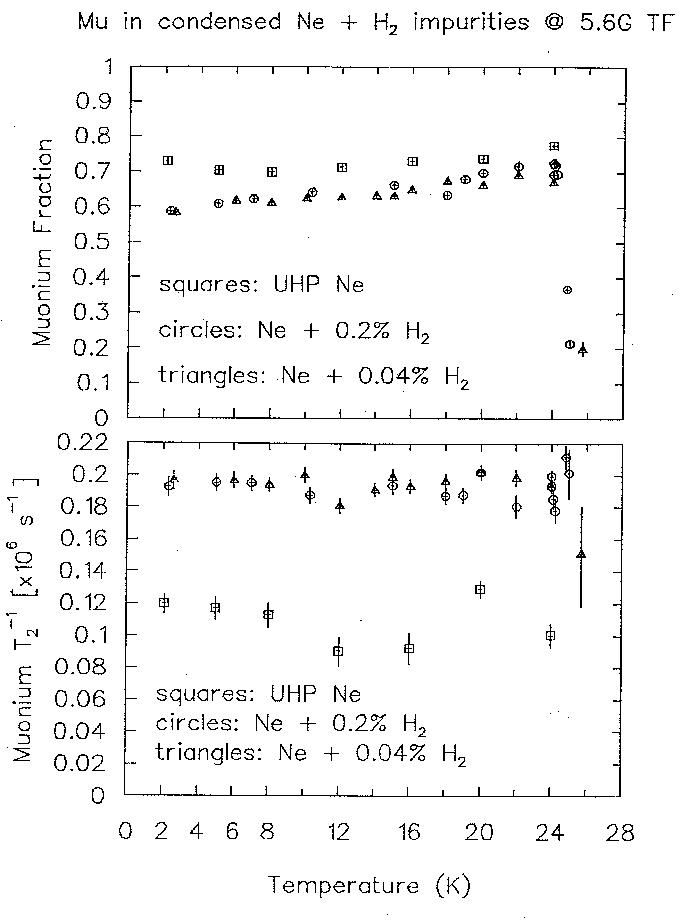Muonium in Solid Neon with Impurities
Unlike in gaseous neon,
where there is virtually no muonium (Mu) formation,
a large fraction of the positive muons (µ+)
stopped in liquid neon (l-Ne) and even more of those
stopped in solid neon (s-Ne) form Mu via
delayed capture of radiolysis electrons
produced in their ionization track. The temperature dependence
of this fraction reflects the mobility of those electrons
as well as any change in the moderation efficiency of the solid.

The muonium relaxation rate in pure s-Ne is the lowest
ever observed; it is probably due to the small fraction of
natural neon isotopes possessing a magnetic moment.
(The main stable isotope, 20Ne, is spinless.)
A very small amount of H2 impurity serves to
nearly double the Mu relaxation rate; 5 times more H2
has the same effect. One interpretation is that the H2
does not itself relax the Mu atoms but rather causes them to
become localized by disturbing the lattice and breaking the
degeneracy between adjacent interstitial sites.
The weak relaxation due to dilute neon moments
then acts on the static Mu atoms.
If this is true, then the muonium diffusion rate
in pure s-Ne must be nearly temperature independent,
an unusual conclusion.

Muonium relaxation in impure s-Ne fits best to a
gaussian relaxation function (power law = 2), whereas
the function in pure neon is halfway between gaussian
and lorentzian (power law = 1). This would appear to
support the conclusions described above, since
static Mu atoms in random local magnetic fields due to
a dense, regular array of randomly oriented moments
would be expected to exhibit gaussian relaxation
and the effect of motion is always to cause a trend toward
more lorentzian behaviour. However, the moments in pure Ne
are almost certain to form a sparse, random array,
which should give a lorentzian relaxation even in the static limit.
The gaussian character of the relaxation is further borne out
by measurements in zero and weak longitudinal field
(ZF/wLF).
One possible conclusion is that the relaxation in s-Ne
is not caused by nuclear moments at all, but rather by a very
small departure of the interstitial site from cubic symmetry
(possibly due to defects, which would explain its enhancement
by H2 impurities but not the fact that this effect
is saturated at 0.04% impurities), which in turn spoils the
degeneracy between triplet Mu levels in zero field and causes
a minute splitting of the Mu precession frequencies in wTF.
In this picture Mu is static in s-Ne at all T.
What do you think? A really good explanation and
a suggestion for a definitive experiment will get your name
on the paper!
Author: JHB.
Figure created 1993.
See TRIUMF Expt 599.
Prepared by
Jess H. Brewer
Last modified: Mon Dec 1 17:47:47 EST


